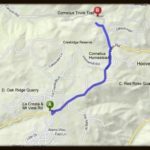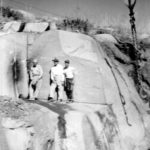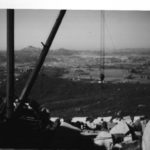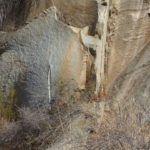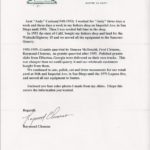The Hoover Mine
Wellington Isaac Hoover moved to Lakeside, CA in 1893 and then later to Dehesa. He married Elizabeth Maud Young in 1908; they had 14 children, seven sons and seven daughters. In 1930, the local paper reported that Mr. W. Hoover of Lakeside and Mr. Porter of Hillsdale were looking over some mining property east of the Cornelius place. This must have been about the time he purchased the Hoover Mine. He was reported to mine silica quartz from his own mine in La Cresta. He hauled the ore with horses and wagons and later with trucks. Wellington was a bonafide prospector with legitimate mining interests.
Jerry Schultz described his visit to the Hoover Mine as a child. “In 1934, gold was worth $20.67 an ounce, a tidy sum during the Great Depression and equal to a week’s wages for those lucky enough to have a job. I remember tagging along with my father, Harley, from our cabin in La Cresta for a jaunt to the Cornelius ranch for a visit with good friend Barney. Dad mentioned that he would also drive to an active goldmine known locally as the Hoover Mine. After visiting at the ranch, we proceeded south via a barely discernible dusty, bumpy dirt road through the open grazed pasture, viewing a small decorative windmill of quartz on the western hilly slopes. These sites had been worked during exploratory digging. The seldom used meandering so-called road soon disappeared as we approached a two-track trail hacked through tall, heavy brush. Faint tire tracks led through manzanita, sumac and scrub oak. A hand-painted sign loomed ahead ‘Keep Out/ No Trespassing!’ Our arrival was announced by the barking of several mean looking dogs. Finally, approaching the encampment, a trio of shirtless, menacing looking men suddenly appeared from under the bows of an oak tree. They all wore full black beards. To me, it was a scary scene; the old man, recognizing the car, approached and shouted a friendly greeting to dad. The men gathered near an old stump and a nickel sack of Bull Durham was passed around. They talked about water, the economy, hunting, and trapping. Overheard words included: homestead, staking a claim, improvements and assay office.
“Picks, shovels, and several star drill bits lay near the tunnel entrance. An all metal wheelbarrow with iron spokes and rim was full of quartz. In a wooden box, stenciled 30% dynamite, there were partially exposed sticks of dynamite nestled in sawdust. Wandering to the tunnel opening, a heavy iron-bound door guarding the mine was ajar revealing a pitch black interior. Peering inside, nothing was visible. I did not go inside. The miners were secretive and never discussed their success or failure of finding gold. Presumably their arduous labor was productive because the mine was worked continually for a number of years.
“In 1938, as adventurous Crest teenagers, hiking or riding bikes down the shortcut trail to the Hoover Mine was considered just something to do. We would travel the easy three mile route to the abandoned site. On the northwestern hillside, a three foot high pyramid of rocks was an indicator of a miner’s claim site. The marker was known as a monument in claimant’s parlance. Concealed within the rock pile was a Prince Albert tobacco can. This time honored practice provided weather proof protection for the owner’s name, claim number, and hand sketched diagram indicating the claim’s boundaries. The government issued patents to miners who proved the presence of valuable minerals in their claims. These documents functioned as deeds. Once the miner got his patent, the land belonged to him. However, improvements had to be made annually. Nearby, several areas had been worked as shown by the shallow diggings and broken quartz rocks.
“Most teenagers and many young adults that lived on ‘the hill’ visited the Hoover Mine at one time or another. It was a favorite isolated destination for more than one reason!
“My last visit to the mine occurred in 1963. Accompanied by my eight year old daughter, Karen, I drove to the site in our 1946 Willys Jeep. The areas looked familiar but much smaller in scope. The massive iron door that formerly guarded the tunnel had been ripped from its hinges and was nowhere to be seen.
“We explored the former campsite and paid little attention to the poison oak laden gulch. Unfortunately, Karen acquired a serious case of poisoning. The painful rash and irritating welts on her face and arms lasted for days.”
Red Rose Quarry
The Red Rose Quarry – 1940-1950s
The Red Rose Quarry was located off Old Mountain View Road. It was owned by Andy Carlsen in 1958 and worked from the 1940s to the 1950s. This stone was quarried under the name “Red Rose Quartzite.” The stone was used mainly in walls and as facing and most notably was found in the original façade of Grossmont Hospital.
The deposit consisted of red, iron-oxide stained quartzite. The rock was massive, with steeply dipping joint planes. The blocks were blasted, pried loose, and then split with plugs and feathers. In 1958, the quarry face was about 250 feet long, and 30 feet high at its highest point; the quarry floor was 100 feet wide at its widest point.
Oakridge Quarry
This quarry was located off of La Cresta Heights Rd. past Kent Drive. It is believed to have been a white marble quarry that produced mostly small ornamental work. Little could be found on this quarry other than a map showing its location.
Birk's Goldmine
Birk’s Goldmine – 1926-1950

No one knows how productive the mine was, but the mine and its owner did create a lot of interest. Birk Merrifield was a bachelor most of his life. Bev Nerbonne related that her parents, Mr. and Mrs. Bill Jenkins, met Birk in 1926 when they homesteaded their 120 acre ranch. He gave them good advice and they became lifelong friends. Birk Merrifield was born June 7, 1881 in Kentucky. He was a mountain man. His ranch was located off the old Suncrest Grade. His cabin had been an old saloon, which Birk tore down in sections and drug into place with his team of horses. He added rock work all around and various types of ice plant making it a very formidable structure. Out back he had an outhouse. He was a very independent person and raised a huge garden and sold extra vegetables. Birk had goats for milk and butter. He also raised tobacco which Bev would see hanging in the barn to dry. His grape vineyard provided the makings for his wine. He sometimes showed the kids his gold mine. Even after the shaft was deepened no gold was ever found to Bev’s knowledge. In 1947, Birk gave up his bachelorhood and married Bea Burnham. Bea reported that Birk was a fine husband. They lived on the homestead until 1950 when Birk died.
The Suncrest Silver Gray Quarry
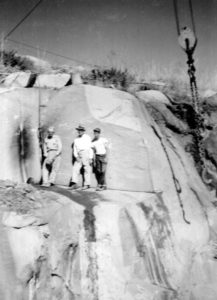
The Suncrest Silver Gray Granite Quarry 1937-1970
The Suncrest Silver Gray Granite Quarry was founded by an old time quarryman, Charles Ross, on horseback, on an old trail that passed in from the quarry site; the year is unknown. The 40 acre upper quarry property, located off the old Suncrest Grade near the present day water tank, was purchased by Fred Clemens from the Cornelius family in 1935. It was worked from 1937 until 1955. The 37 acre lower quarry was purchased in 1939 and was worked until September 1970 when the Laguna Fire destroyed their valuable equipment including their granite wire saw and polishing and finishing equipment. The quarry was then closed.
Duncan McDonald, Ervin Kouns, and Fred Clemens were the quarrymen associated with the quarry. For many years they produced fine grain light gray granite which was shipped throughout the country including a federal building in New York City. They also had a retail business on Imperial Avenue. Raymond Clemens ran the quarry with his father, Fred.
From 1945 to 1947 Daniel McCarthy leased the quarry from Fred Clemens. He brought down a large derrick from Raymond, CA and erected it. McCarthy also rented the old log cabin house Clemens owned on Alta Lane across from the old water tank where a crew of seven men lived while erecting the derrick and other equipment. He bought the cabin from Mr. Challand who owned the La Cresta Store. From 1953-1955 granite was quarried by Duncan McDonald, Fred Clemens, Raymond Clemens, and Andy Carlsen.


